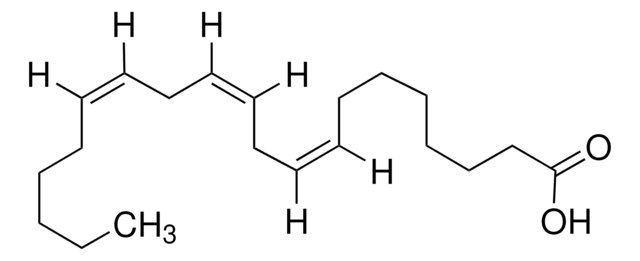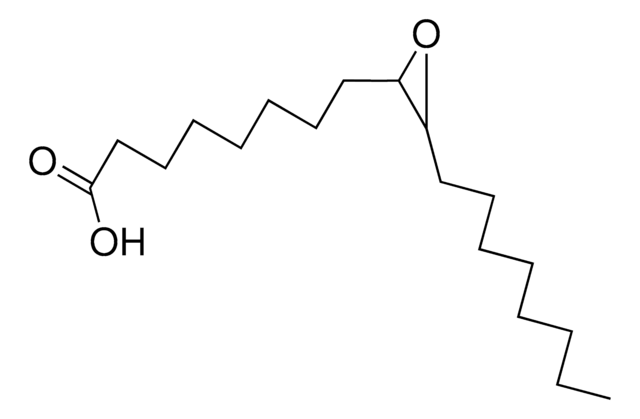推荐产品
品質等級
化驗
≥95%
濃度
~100 μg/mL in ethanol
脂質類型
omega FAs
儲存溫度
−20°C
SMILES 字串
CCCCC\C=C\CC1OC1C\C=C\C\C=C\CCCC(O)=O
InChI
1S/C20H32O3/c1-2-3-4-5-9-12-15-18-19(23-18)16-13-10-7-6-8-11-14-17-20(21)22/h6,8-10,12-13,18-19H,2-5,7,11,14-17H2,1H3,(H,21,22)/b8-6+,12-9+,13-10+
InChI 密鑰
DXOYQVHGIODESM-ATELOPIESA-N
包裝
在氩气下包装
訊號詞
Danger
危險聲明
危險分類
Eye Irrit. 2 - Flam. Liq. 2
儲存類別代碼
3 - Flammable liquids
水污染物質分類(WGK)
WGK 1
閃點(°F)
48.2 °F - closed cup
閃點(°C)
9 °C - closed cup
L Yang et al.
British journal of clinical pharmacology, 80(1), 28-44 (2015-02-07)
There is increasing evidence suggesting that epoxyeicosatrienoic acids (EETs) play an important role in cardioprotective mechanisms. These include regulating vascular tone, modulating inflammatory responses, improving cardiomyocyte function and reducing ischaemic damage, resulting in attenuation of animal models of cardiovascular risk
Yong Zhou et al.
Shock (Augusta, Ga.), 47(5), 638-645 (2016-10-19)
Acute lung injury (ALI) is characterized by rapid alveolar injury, vascular leakage, lung inflammation, neutrophil accumulation, and induced cytokines production leading to lung edema. The mortality rate of patients suffering from ALI remains high. Epoxyeicosatrienoic acids (EETs) are cytochrome P450-dependent
Huichen Zhao et al.
Laboratory investigation; a journal of technical methods and pathology, 97(7), 782-791 (2017-03-21)
Epoxyeicosatrienoic acids (EETs) are the epoxidation products of arachidonic acid catalyzed by cytochrome P450 (CYP) epoxygenases, which possess multiple biological activities. In the present study, we aimed to explore the role and effects of CYP epoxygenases/EETs in wound healing in
Yindi Ding et al.
The Journal of pharmacology and experimental therapeutics, 350(1), 14-21 (2014-04-26)
Cytochrome P450-derived epoxides of arachidonic acid [i.e., the epoxyeicosatrienoic acids (EETs)] are important lipid signaling molecules involved in the regulation of vascular tone and angiogenesis. Because many actions of 11,12-cis-epoxyeicosatrienoic acid (EET) are dependent on the activation of protein kinase
Jihong Lin et al.
Theranostics, 10(17), 7857-7871 (2020-07-21)
Rationale: Vasoregression secondary to glial activation develops in various retinal diseases, including retinal degeneration and diabetic retinopathy. Photoreceptor degeneration and subsequent retinal vasoregression, characterized by pericyte loss and acellular capillary formation in the absence diabetes, are also seen in transgenic
我们的科学家团队拥有各种研究领域经验,包括生命科学、材料科学、化学合成、色谱、分析及许多其他领域.
联系技术服务部门







